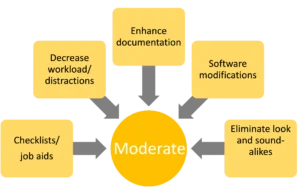Prepare…then jump skillfully into solution mode
The saying “Don’t bring me problems, bring me solutions” is pretty popular among leaders. And I get it, the idea is to avoid creating a culture of complaining. But the ability to skillfully identify and communicate about issues is much different than complaining. When individuals and teams know how to recognize and communicate problems, they become empowered to collaborate to develop solutions. In a culture of problem-solving and continuous improvement in an environment where potential issues are detected early, people feel safe delivering bad news and precious time isn’t wasted while small issues turn into crises.
One of the most valuable characteristics that an individual can bring to an organization is resourcefulness. And this means the ability to recognize opportunities for improvement and the know-how to develop and implement effective solutions.
First, Define the Problem
The challenge with identifying problems is that people rarely take the time to define them clearly. Hence, the fine line between a complaint and a problem. Here’s a quick guideline to encourage your team to bring up problems in a more productive way:
3 Words + Frequency + Impact = Problem Statement
3 Words: Start by getting your problem down to three words. For example,
-
Customers call back
-
Ingredients not available
-
Check-in Time Slow
-
Invoices have errors
+ Frequency: It’s important to include facts or data to clarify the frequency of the problem. For example,
-
25% of Customers call back
-
50% of Natural ingredients are not available when needed
-
Average Check-in Time has increased by 9 minutes in the last 6 months
-
10% of invoices have 1 or more errors
+ Impact: This is the “so what?” part of the equation. For example,
-
25% of Customers call back resulting in customer dissatisfaction and employee overload
-
50% of Natural ingredients are not available when needed resulting in significant production delays
-
Average Check-in Time has increased by 9 minutes in the last 6 months resulting in customer dissatisfaction
-
10% of invoices have 1 or more errors causing significant rework and reconciliation issues
Important to note, that there are two biggies that love to sneak into Problem Statements where they absolutely do not belong…they have their own place in an improvement, but the CAUSE and the SOLUTION don’t belong in the Problem Statement.
Define your problem well, and you almost have a solution!
This was said originally by Steve Jobs, and it’s almost true. As part of the Lean Six Sigma structure, we learn the tools and discipline to segment our problem-solving into 5 steps. And the first of these steps is to Define the problem…
-
Define…the problem
-
Measure…the problem
-
Analyze…to verify the root cause of the problem
-
Improve…the situation (solve the problem)
-
Control…the situation (validate results and ensure sustainability)
Explore Proven Solutions

With the problem Defined, Measured, and Analyzed, it’s now time to “bring me a solution”. When we come up with solutions, it’s not always something new, innovative, or amazing. As a matter of fact, experts in the field of innovative solutions have calculated that over 90% of the problems have been solved somewhere before.
The point is that we want to be as creative and innovative as necessary to get great results on our project. But to also understand that not everything will be a great new concept or discovery.
The idea is to understand when and how to utilize proven solutions because many of the problems that you are likely to encounter have been solved before. There’s no need to re-invent the wheel or come up with a unique solution for every problem. Through the many years of applying and perfecting these solutions, they can be seen almost as a ready-to-go solution because, of course, any solution will need to be adapted to your specific scenario.
Some examples of proven solutions are 5S, Kanban, Just-in-Time processing, Load-leveling, Work Cell Design, and the Visual workplace.





It’s all about Options!
When creating solutions, we explore the many proven solutions to determine whether those methods might solve the specific root causes of our problem. And while they often will, sometimes, we need to add unique solutions or ideas to make it work for our specific scenario. If proven solutions will not result in eliminating or minimizing the root cause of the problem, then we will focus on brainstorming and process design techniques to really target those root causes.
Regardless, when faced with a problem, we should aim to gather multiple solution options. It’s very commonplace for solutions to be pre-determined before the problem is even identified. Rather than exploring proven solutions or developing innovative ideas, people stick to the obvious ones. Or the solution is determined using limited criteria; perhaps a mix of opinions, gut feeling, facts, and data. When this occurs, the end result is predictably underwhelming at best and a costly waste of time and resources at worst.
Solution Ideas… Quick Reference
Just as a quick reference, here are a few examples of the Strong solutions, which include ideas that remove waste or simplify the process, standardization of equipment or processes, automation of a streamlined process, having demonstrated leadership support (which is necessary for good results) and improving the layout to create efficiencies.

Some moderate-type solutions would include things like creating checklists and job aids, minimizing workload or distractions, improving existing documentation, technical or software modification, and eliminating look-alikes and soundalikes.

And on the weaker side of ideas, we would see things like adding double checks. Adding warnings or reminders. Or coming up with no solution at all – suggesting that we need to continue analysis. And one of the weakest would be re-training.

Solution Selection Tools
When coming up with solution ideas, it can be a real challenge to allow ourselves to be creative. Especially when we have been in the process for a while – we begin to develop a lot of assumptions about what won’t work.
The Filter Matrix
When we have identified the potential solutions, we can use the Filter Matrix – a simple 2 by 2 matrix – to evaluate the options on the two major criteria. Typically, when we are selecting a solution, the main criteria are the Impact on the Problem (or the Benefit) weighed against the Time, Resources, or Cost to implement the solution. So the best option would be one that is a high benefit that requires low resources. And we would likely rule out anything that is low benefits and high costs. We might have options that are high benefits that come at a high cost, and we’d have to determine whether we have the time and resources available. If we do, then it might be the best option. Otherwise, we may end up selecting a smaller benefit that can be done quickly or with little resources required. This simple tool can be used if there are not too many options or if the criteria are relatively straightforward.

To use a criteria matrix, we start by solidifying the criteria. For Solution Selection, the criteria fall into 3 categories; Impact or Benefit, Resources Required, and the Change Readiness of the people involved.
The Cannsult Solution Selection template makes it easy to solidify your criteria so that you can compare your options to the most important criteria for your project.

Next Steps… Design the Future State
By this point in a project, you will have explored many options for solutions, and you will have selected the best option based on specific criteria. Now is the time to work out all the details for the new ways of working. And that means updating our process map to show how work will be done, solidifying new procedures, and creating job aids and references to standardize the work. It also means that we have the opportunity to clarify roles to make sure that everyone in the process understands who does what.
There are some important tools and techniques taught in Green Belt training to make sure that your new process isn’t full of unpleasant surprises we’ll talk through methods for mistake-proofing and minimizing the risks such as…
So, if you made it this far, you now have greater insight into why the saying, “Don’t bring me problems, bring me solutions” has its challenges.









